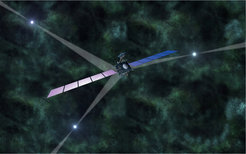How interstellar beacons could help future spacecraft find their way across the universe

Have you ever asked yourself how the starship Enterprise in the TV series Star Trek found its way through the depths of space? What navigation system did it use to travel through the galaxy? Pulsar stars might be the key to this interstellar navigation - not only in science fiction but also in the near future of space flight. Current spacecraft navigation relies on measuring the time it takes a radio signal to travel from Earth to the spacecraft and back - which not only requires several antennae on Earth but also becomes more and more imprecise the farther away the spacecraft moves. An independent and autonomous system using pulsar signals could provide an interesting alternative.
When stars much more massive than our Sun reach the end of their lives, their final demise is marked by a dramatic supernova explosion that destroys most of the star. But many leave behind compact, incredibly dense remnants known as neutron stars. Those detected have strong magnetic fields that focus emission into two highly directional beams. The neutron star rotates rapidly and if the beam points in the direction of the Earth we see a pulse of radiation at extremely regular intervals - hence the name pulsar.
Prof. Becker and his team of scientists at the Max Planck Institute for Extraterrestrial Physics are developing a novel navigation technology for spacecraft based on the regular emission of X-ray light from pulsars. Their periodic signals have timing stabilities comparable to atomic clocks and provide characteristic time signatures that can be used as natural navigation beacons, similar to the use of GPS satellites for navigation on Earth. By comparing the arrival times of the pulses measured on board the navigator spacecraft with those predicted at a reference location, the spacecraft position can be determined with an accuracy of few kilometres, everywhere in the solar system and far beyond.
Rocket propulsion in its current form relegates all plans for journeys through our Galaxy to the far future. Nonetheless, the pulsar-based navigation system could be in use in the near future for spacecraft, especially as the development of X-ray mirrors is progressing fast and lightweight mirrors might become available in 15-20 years. Prof. Becker gives some examples: "These X-ray beacons could augment the existing GPS/Galileo satellite navigation systems and provide autonomous navigation for interplanetary space probes and future manned missions to Mars."












